Home > Junko's Blog > Creating Well-being Indicators of Japan, by Japan, for Japan
March 05, 2013
Creating Well-being Indicators of Japan, by Japan, for Japan
from Japan for Sustainability (JFS) Newsletter No.126
http://www.japanfs.org/en/mailmagazine/newsletter/pages/032635.html
Movements to measure progress not only by Gross Domestic Product (GDP) but also by well-being indicators have become active worldwide. As introduced in some of our previous newsletters, many local governments and communities across Japan have been developing their own indicators of well-being and prosperity. But, what's happening on the national level?
In Japan, efforts to set up alternative indexes to GDP have been under way for a long time. Back in 1974, the former Economic Planning Agency (EPA, now merged with the Cabinet Office) introduced a set of "Social Indicators." As negative impacts from rapid economic growth including pollution and population concentration became apparent, a shift from overdependence on a monetary index seemed appropriate to the times. These indicators were used until 1984. In 1986, the EPA revised them as New Social Indicators (NSI), which were used until 1990. These indicators focused more on changes in individuals' lives as lifestyles diversified in step with higher living standards and changes in values after rapid growth ended. The NSIs included indicators that are internationally comparable, as well as more subjective indicators.
In the late 1980s, when people started to seek greater material abundance, it became necessary to develop an indicator to measure these tendencies, and the "People's Life Indicators" were introduced in 1992. It was notable in that these included indicators for local-level comparisons to measure the differences between localities in order to clarify the impacts of the immense concentration of population in Tokyo. It was used until 1999, and then in 2002 another set of indicators, the "Life Reform Index", was introduced and used until 2005.
In 2010, a "Commission on Measuring Well-Being" (hereafter the Commission) was established under the aegis of the national government's Cabinet Office, with the participation of various experts. Its stated aim was to promote research and studies on new growth and well-being, as well as to develop and improve statistics on related indicators, as a part of a "New Growth Strategy" adopted by the government. The discussions of this Commission were published in the December 2011 report "Measuring National Well-Being -- Proposed Well-being Indicators--."
Three categories of indicators were delineated: socio-economic conditions, physical and psychological health and social relatedness, with subjective and objective indicators suggested for each category. The report also includes a deeper discussion of overall factors that underlie the "well-being" of people in Japanese society.
According to a survey of preferences conducted in fiscal years 2009 and 2010, people apparently evaluate their well-being in terms of factors such as family, health, household budget (income and consumption), and mental relaxation (or free time).
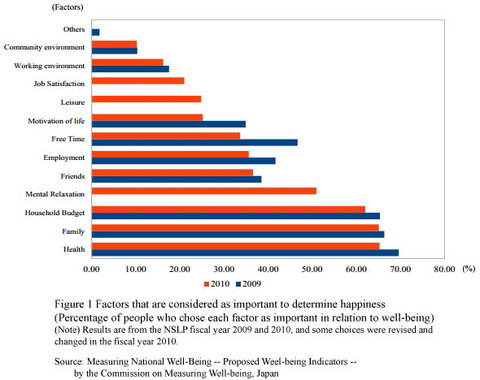
At the same time, the results of past research and studies do not clearly show that sustaining nature, local communities, natural resources, natural life forms, and the Earth's environment has any effect on the current generation's well-being. Even so, the Commission deemed it undesirable to allow the current generation to maintain their well-being at the cost of sacrifices to be suffered by future generations, and so it also considered "sustainability" in addition to the three main categories. The framework for its proposed well-being indicators can be seen on the following weblink.
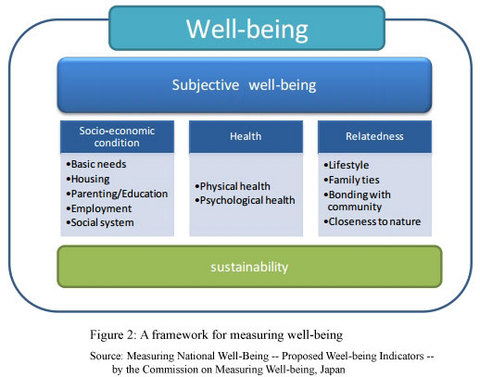
For the details and approaches of each proposed indicator, please refer to the following URLs:
Japanese
http://www5.cao.go.jp/keizai2/koufukudo/koufukudo.html
English
http://www5.cao.go.jp/keizai2/koufukudo/pdf/koufukudosian_english.pdf
The following points were made by the Commission and illustrate some aspects of drawing up well-being indicators that are specific to Japan. They reflect the results of past studies of subjective well-being as well as a pilot study targeting the younger generation carried out as part of an experiment in understanding Japanese perceptions of well-being from multiple viewpoints.
(1) Japan is no exception in suffering from the "paradox of happiness."
In industrialized countries, the phenomenon of the "paradox of happiness" refers to the fact that an increase in GDP, indicating economic affluence, does not lead to an increase in individual well-being and Japan is no exception in this regard.
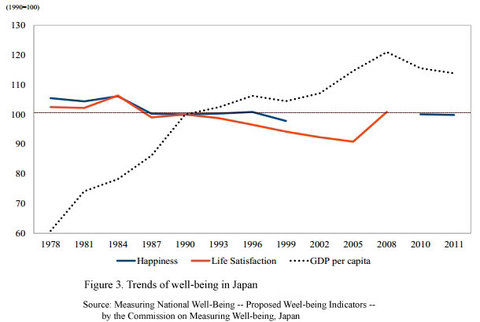
(2) The Great East Japan Earthquake in 2011 changed people's perception of happiness.
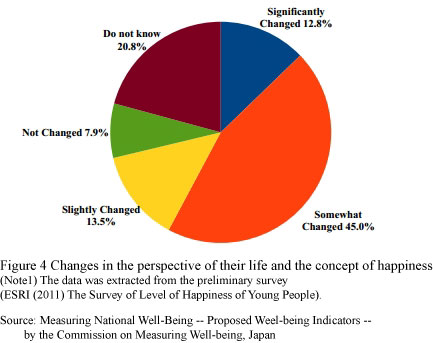
(3) Japan's unique "subjective well-being" graph
Japan's graph in Figure 5 shows two distinctive peaks: one at 5 (an intermediate value) and the other comparatively higher, at 7 or 8 (very happy). Similar graphs for Denmark and the U.K. show a single asymmetric peak at about 8, and are very different from the Japanese graph.
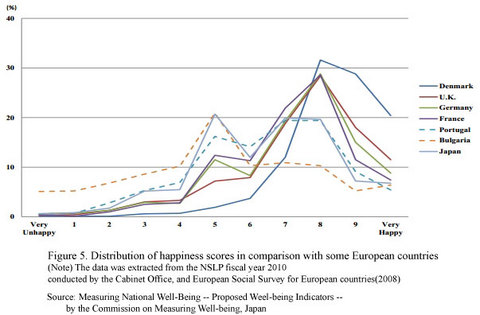
Thus, when we evaluate well-being, the proportion of people giving a lower well-being score is also considered as an important part of the index, in addition to average scores (happiness gap).
(4) The elderly suffer unhappiness in Japan.
In other countries, the relationship between age and well-being is expressed by a U-curve. But compared to other countries such as the United States, the happiness level of Japanese people entering their senior years does not increase.
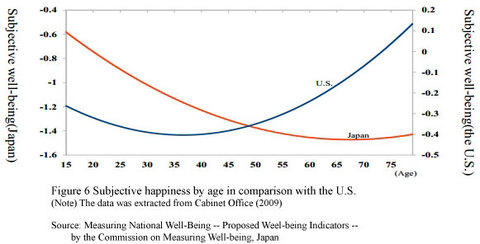
(5) Three aspects of understanding the Japanese perception of well-being from multiple perspectives.
The report indicates three aspects of Japanese well-being perception from multiple perspectives: 1) the gap between the ideal state of happiness and the real state of happiness, (whether one is happier than the ideal state or not) 2) the expected level of happiness in the future (whether well-being will increase or not) 3) one's relative achievements in comparison with others (the sense of what is average).
When the gap between the ideal state and reality is wide, it is important to identify the ultimate reason for the gap. Also, even when current well-being is high, when people feel their well-being will probably decline in future, it means that the society has a problem. Well-being is what we seek, but even as we seek greater happiness, we can still feel a sense of well-being in the course of ordinary life and in the absence of misfortune.
Compared to people in western countries who seek well-being as a way of promoting their sense of self-respect, Asians' sense of subjective well-being comes from "relationships," for example, from thankfulness and consideration for others, and living in harmony with nature. Also, measuring people's sense of what is average is important in a context of understanding cultural gaps and the source of Japanese people's well-being.
A pilot study of the younger generation tends to verify the effectiveness of the three categories noted above for identifying people's sense of well-being from multiple perspectives. A notable feature of this study is that many people answered that their ideal state was not "feeling happiness 100% of the time," but "feeling happiness 70-80% of the time and feeling unhappiness 20-30% of the time," or "feeling happiness 50% of the time."
Looking for differences in ideal state, relatively more people experiencing extremes of present well-being, that is, both those who scored 10 (very happy) or 0 (very unhappy), chose as their ideal state "feeling only happiness (10)." But in general, many people chose "feeling happiness for 70-80% of their time" or "feeling happiness for 50% of their time," reflecting an overall trend. If the ideal state of Japanese well-being does not mean "feeling happiness for 100% of the time," low average scores of happiness to a certain degree may not necessarily indicate immediate well-being problems.
According to Yukiko Uchida, an associate professor at Kyoto University's KOKORO Research Center, well-being in western countries is achieved by maximizing the desirability of one's own attributes, but well-being in eastern countries includes a perception that "too much good will eventually lead to unhappiness," "It is life to experience equal measures of good and bad," and "One must consider one's balance with the surrounding environment."
Uchida points out the importance of the sense of what is average (a cooperative happiness scale) to Japanese-style well-being. She used the study on the younger generation to statistically analyze the relationship between current well-being and the sense of average and found a correlation. A cooperative well-being scale is measured through items such as "I think people close to me are also feeling happy, not only myself," "I don't have any serious worries," "I am doing fine just like the people around me," "I feel recognized by people around me," "I have a stable everyday life even though it is ordinary," "I think I am as happy as the people around me," "I think I am making my significant other happy," "I am confident that I am achieving an average life just like people around me," "I can do what I want to do without causing someone trouble."
Based on these results, proposed indicators for Japanese subjective well-being are given in the report as follows; (1) Subjective sense of happiness, (2) Ideal state of happiness, (3) Expected level of happiness in the future, (4) Sense of what is average, and (5) Emotional experience and gaps in well-being within households.
Some of the indicators proposed in this tentative plan cannot be understood as data at present, and require application of data from public and private sectors. In order to utilize subjective data on subjective well-being to implicate policy, a set of panel data is needed to analyze unobserved individual differences and household differences as well as individual responses to particular policies and life events by continuously investigating the same subjects. This is another issue for Japan in the future.
As the report concludes, "This proposal is only the starting point of the discussion on well-being in Japanese society," and despite many issues, it constitutes an interesting step toward identifying well-being indicators distinct from those in western world and that are unique and particularly helpful to Japan. I look forward to further study and discussion of these indicators in the future.




